Adrien Bitton
Neural Granular Sound Synthesis
Aug 31, 2020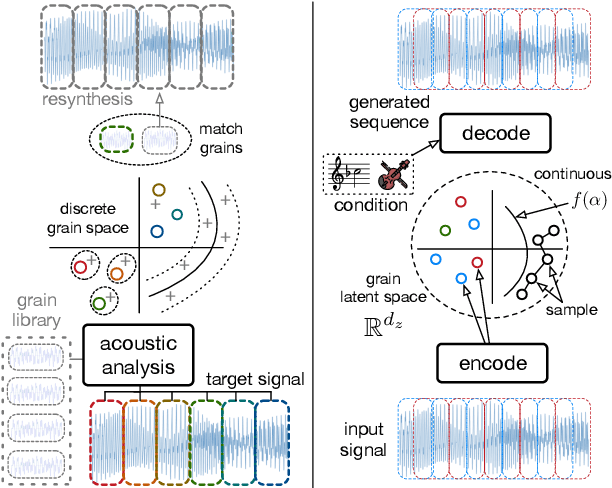
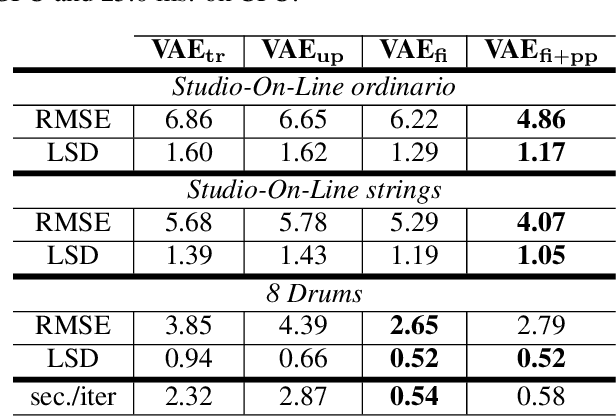
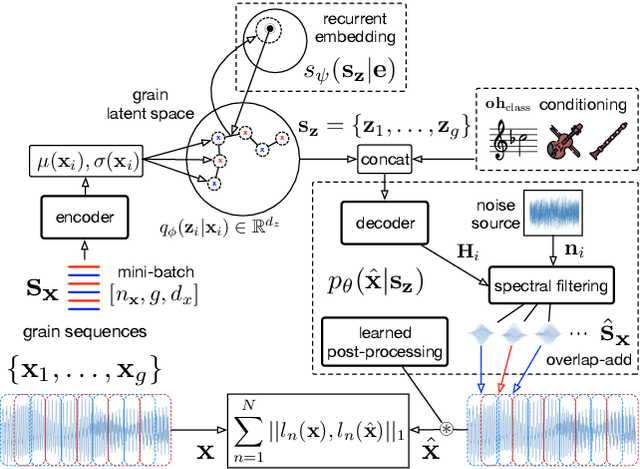

Abstract:Granular sound synthesis is a popular audio generation technique based on rearranging sequences of small waveform windows. In order to control the synthesis, all grains in a given corpus are analyzed through a set of acoustic descriptors. This provides a representation reflecting some form of local similarities across the grains. However, the quality of this grain space is bound by that of the descriptors. Its traversal is not continuously invertible to signal and does not render any structured temporality. We demonstrate that generative neural networks can implement granular synthesis while alleviating most of its shortcomings. We efficiently replace its audio descriptor basis by a probabilistic latent space learned with a Variational Auto-Encoder. A major advantage of our proposal is that the resulting grain space is invertible, meaning that we can continuously synthesize sound when traversing its dimensions. It also implies that original grains are not stored for synthesis. To learn structured paths inside this latent space, we add a higher-level temporal embedding trained on arranged grain sequences. The model can be applied to many types of libraries, including pitched notes or unpitched drums and environmental noises. We experiment with the common granular synthesis processes and enable new ones.
Timbre latent space: exploration and creative aspects
Aug 17, 2020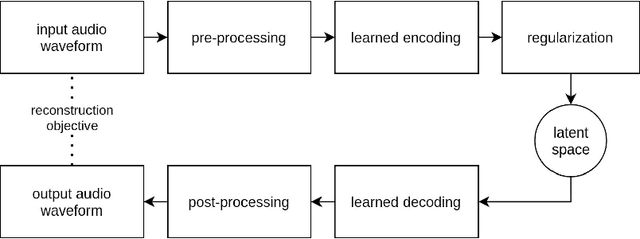


Abstract:Recent studies show the ability of unsupervised models to learn invertible audio representations using Auto-Encoders. They enable high-quality sound synthesis but a limited control since the latent spaces do not disentangle timbre properties. The emergence of disentangled representations was studied in Variational Auto-Encoders (VAEs), and has been applied to audio. Using an additional perceptual regularization can align such latent representation with the previously established multi-dimensional timbre spaces, while allowing continuous inference and synthesis. Alternatively, some specific sound attributes can be learned as control variables while unsupervised dimensions account for the remaining features. New possibilities for timbre manipulations are enabled with generative neural networks, although the exploration and the creative use of their representations remain little. The following experiments are led in cooperation with two composers and propose new creative directions to explore latent sound synthesis of musical timbres, using specifically designed interfaces (Max/MSP, Pure Data) or mappings for descriptor-based synthesis.
Ultra-light deep MIR by trimming lottery tickets
Jul 31, 2020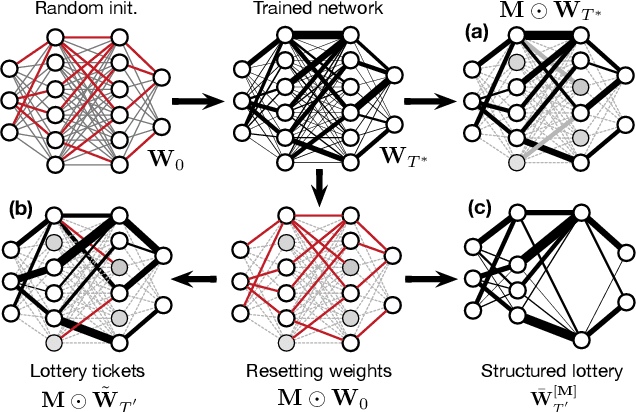
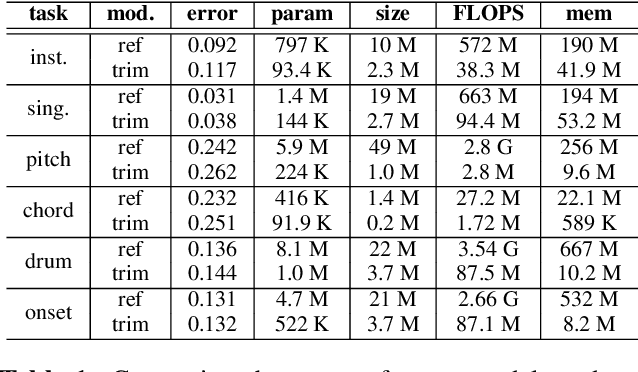
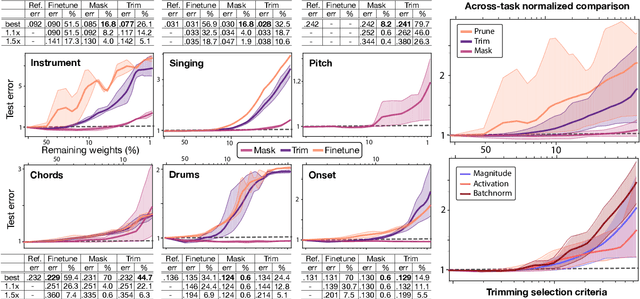
Abstract:Current state-of-the-art results in Music Information Retrieval are largely dominated by deep learning approaches. These provide unprecedented accuracy across all tasks. However, the consistently overlooked downside of these models is their stunningly massive complexity, which seems concomitantly crucial to their success. In this paper, we address this issue by proposing a model pruning method based on the lottery ticket hypothesis. We modify the original approach to allow for explicitly removing parameters, through structured trimming of entire units, instead of simply masking individual weights. This leads to models which are effectively lighter in terms of size, memory and number of operations. We show that our proposal can remove up to 90% of the model parameters without loss of accuracy, leading to ultra-light deep MIR models. We confirm the surprising result that, at smaller compression ratios (removing up to 85% of a network), lighter models consistently outperform their heavier counterparts. We exhibit these results on a large array of MIR tasks including audio classification, pitch recognition, chord extraction, drum transcription and onset estimation. The resulting ultra-light deep learning models for MIR can run on CPU, and can even fit on embedded devices with minimal degradation of accuracy.
Diet deep generative audio models with structured lottery
Jul 31, 2020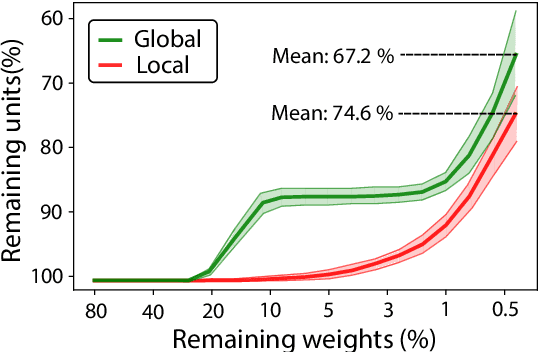
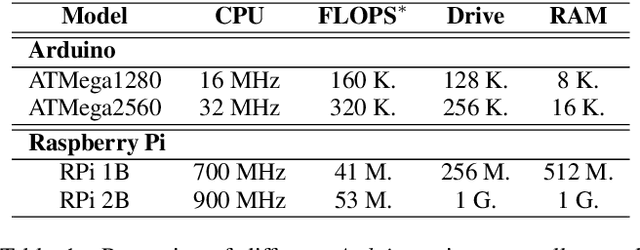

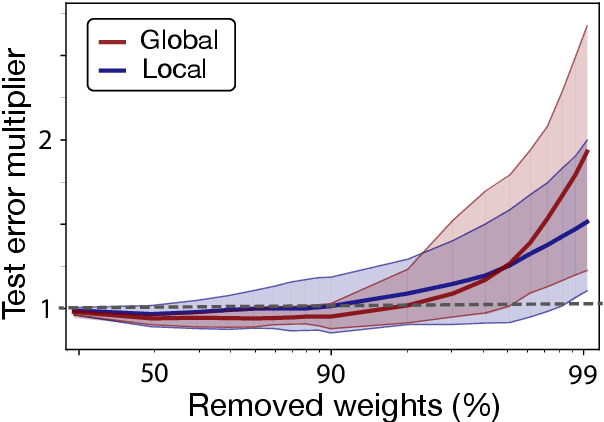
Abstract:Deep learning models have provided extremely successful solutions in most audio application fields. However, the high accuracy of these models comes at the expense of a tremendous computation cost. This aspect is almost always overlooked in evaluating the quality of proposed models. However, models should not be evaluated without taking into account their complexity. This aspect is especially critical in audio applications, which heavily relies on specialized embedded hardware with real-time constraints. In this paper, we build on recent observations that deep models are highly overparameterized, by studying the lottery ticket hypothesis on deep generative audio models. This hypothesis states that extremely efficient small sub-networks exist in deep models and would provide higher accuracy than larger models if trained in isolation. However, lottery tickets are found by relying on unstructured masking, which means that resulting models do not provide any gain in either disk size or inference time. Instead, we develop here a method aimed at performing structured trimming. We show that this requires to rely on global selection and introduce a specific criterion based on mutual information. First, we confirm the surprising result that smaller models provide higher accuracy than their large counterparts. We further show that we can remove up to 95% of the model weights without significant degradation in accuracy. Hence, we can obtain very light models for generative audio across popular methods such as Wavenet, SING or DDSP, that are up to 100 times smaller with commensurate accuracy. We study the theoretical bounds for embedding these models on Raspberry Pi and Arduino, and show that we can obtain generative models on CPU with equivalent quality as large GPU models. Finally, we discuss the possibility of implementing deep generative audio models on embedded platforms.
Vector-Quantized Timbre Representation
Jul 13, 2020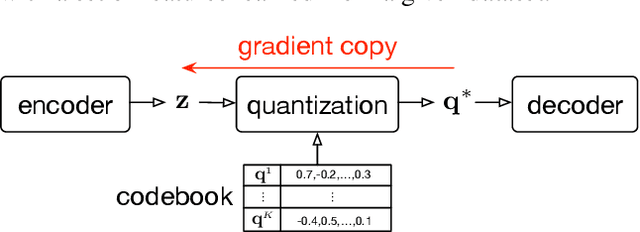
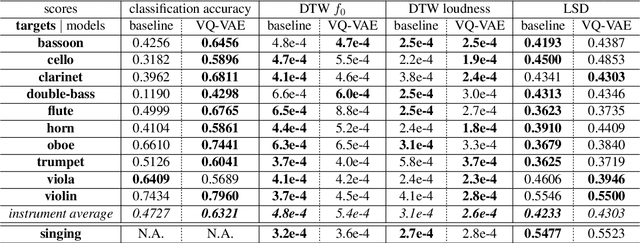


Abstract:Timbre is a set of perceptual attributes that identifies different types of sound sources. Although its definition is usually elusive, it can be seen from a signal processing viewpoint as all the spectral features that are perceived independently from pitch and loudness. Some works have studied high-level timbre synthesis by analyzing the feature relationships of different instruments, but acoustic properties remain entangled and generation bound to individual sounds. This paper targets a more flexible synthesis of an individual timbre by learning an approximate decomposition of its spectral properties with a set of generative features. We introduce an auto-encoder with a discrete latent space that is disentangled from loudness in order to learn a quantized representation of a given timbre distribution. Timbre transfer can be performed by encoding any variable-length input signals into the quantized latent features that are decoded according to the learned timbre. We detail results for translating audio between orchestral instruments and singing voice, as well as transfers from vocal imitations to instruments as an intuitive modality to drive sound synthesis. Furthermore, we can map the discrete latent space to acoustic descriptors and directly perform descriptor-based synthesis.
Assisted Sound Sample Generation with Musical Conditioning in Adversarial Auto-Encoders
Apr 12, 2019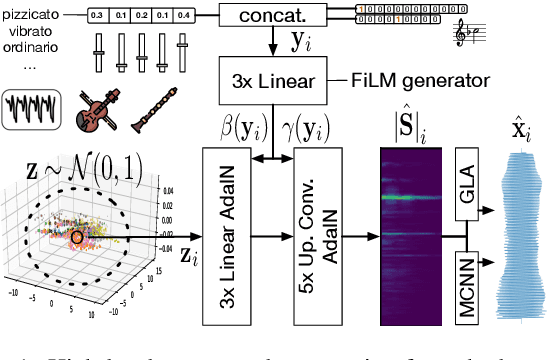
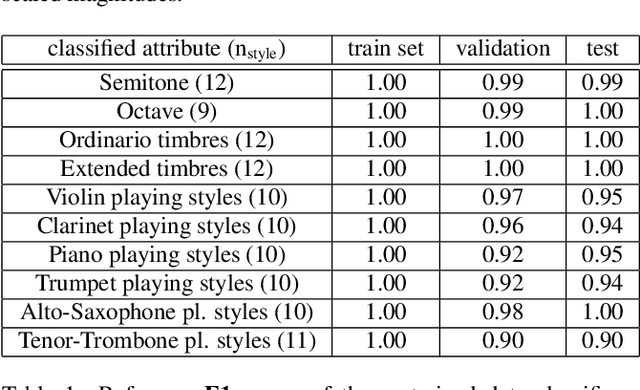
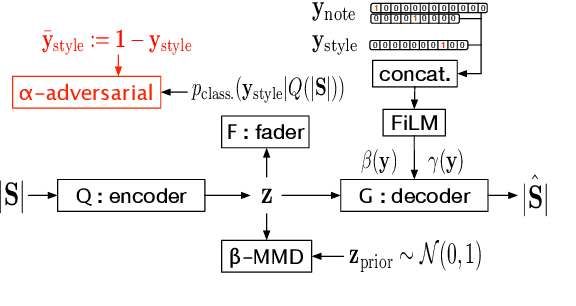
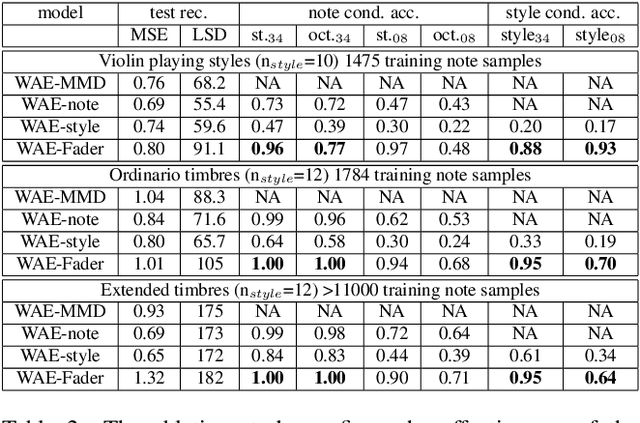
Abstract:Generative models have thrived in computer vision, enabling unprecedented image processes. Yet the results in audio remain less advanced. Our project targets real-time sound synthesis from a reduced set of high-level parameters, including semantic controls that can be adapted to different sound libraries and specific tags. These generative variables should allow expressive modulations of target musical qualities and continuously mix into new styles. To this extent we train AEs on an orchestral database of individual note samples, along with their intrinsic attributes: note class, timbre domain and extended playing techniques. We condition the decoder for control over the rendered note attributes and use latent adversarial training for learning expressive style parameters that can ultimately be mixed. We evaluate both generative performances and latent representation. Our ablation study demonstrates the effectiveness of the musical conditioning mechanisms. The proposed model generates notes as magnitude spectrograms from any probabilistic latent code samples, with expressive control of orchestral timbres and playing styles. Its training data subsets can directly be visualized in the 3D latent representation. Waveform rendering can be done offline with GLA. In order to allow real-time interactions, we fine-tune the decoder with a pretrained MCNN and embed the full waveform generation pipeline in a plugin. Moreover the encoder could be used to process new input samples, after manipulating their latent attribute representation, the decoder can generate sample variations as an audio effect would. Our solution remains rather fast to train, it can directly be applied to other sound domains, including an user's libraries with custom sound tags that could be mapped to specific generative controls. As a result, it fosters creativity and intuitive audio style experimentations.
 Add to Chrome
Add to Chrome Add to Firefox
Add to Firefox Add to Edge
Add to Edge